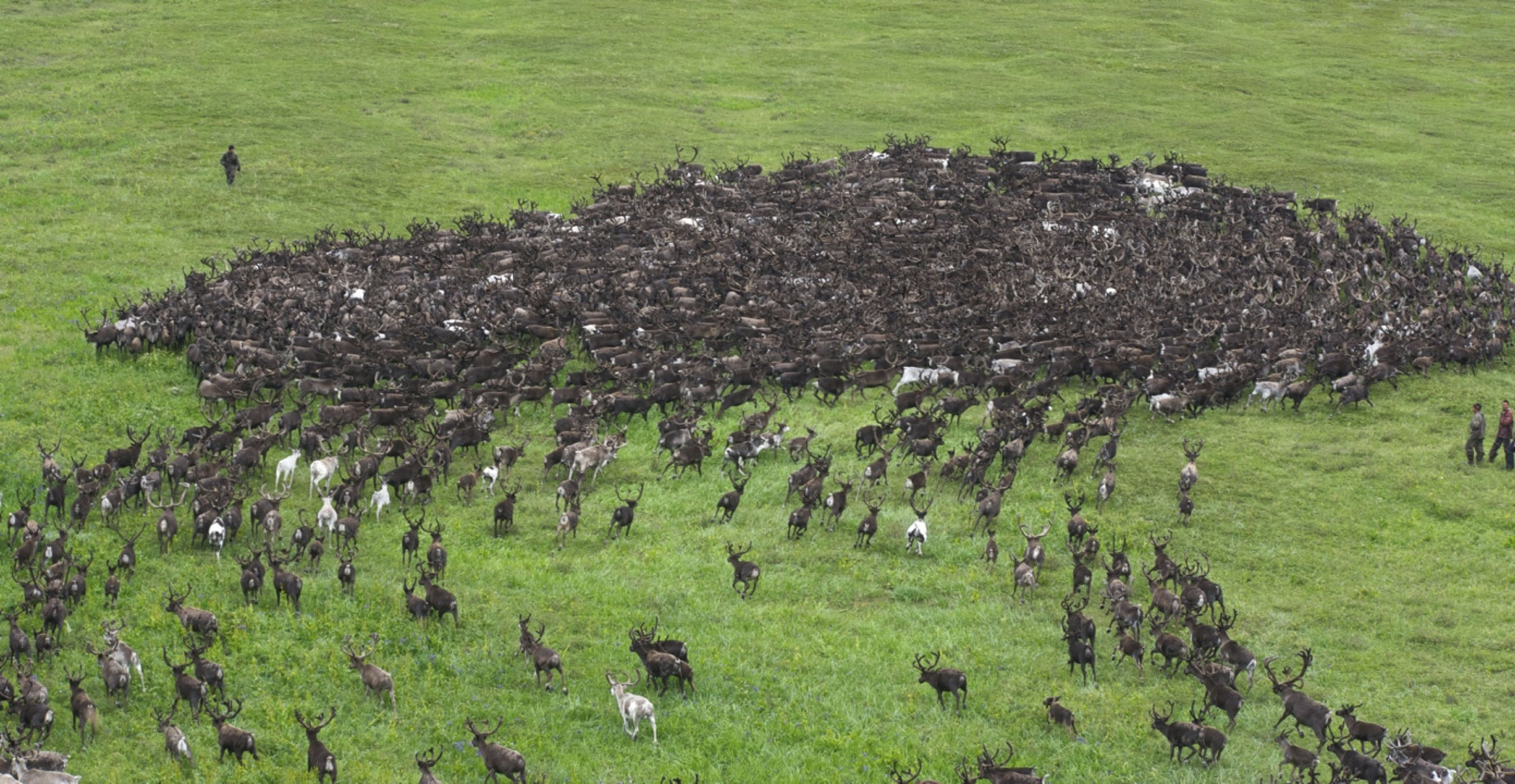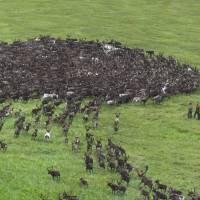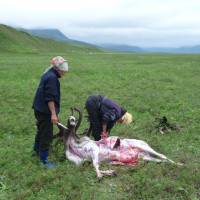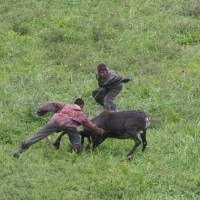The dark herd rushed at the slope like a massive wave crashing ashore. Hitting the base of the steep escarpment they were momentarily lost from my viewpoint; they surged upslope, reemerging into view on the upper terrace as a thundering horde, the vibration of their cloven hoof beats discernible through the tundra turf and clearly audible.
Hurrying herdsmen were in pursuit and with seemingly few commands they somehow turned the herd. The deer reacted as if a predator had appeared before them, perhaps triggered by ancient instincts often reinforced by the regular presence in their domain of wolves and bears.
The view beyond the herd was a vast glacially gouged and fog-enshrouded valley that extended far inland, beyond my vision. A meandering river wound through the landscape reaching the shore at a shallow estuary behind a low beach berm. Tracks along the beach showed where bears had wandered earlier, and upstream several bears were visible fishing in the shallows. Bears in the Russian Far East are notoriously shy, easily spooked and clearly accustomed to being the target of hunters.
Mountains rose on either side of this broad land and extended seaward, protecting the bay and its various coves beyond the beach in an extensive fiord. There, gray whales had greeted our ship in recognizable fashion with their distinctive low bushy blows and mottled backs as we inched our way toward our anchorage.
Far beyond, on the fiord's southern shore, rocky coves sheltered summering mobs of walruses. These snorting, grunting, tusked behemoths lay in relaxed layers. In my wildest dreams I had not imagined realizing the triple goals of bears, whales and walruses in the same day. As part of a longer expedition we had set aside three days to explore the seemingly endless remote coastline of Koryakia (northern Kamchatka) in search of its impressive wildlife as part of a voyage spanning the Bering Strait to Sakhalin and Hokkaido, and almost immediately they bore fruit.
Over more than a decade of visiting this region's remote coasts I had heard repeatedly of the nomadic reindeer herdsmen of Koryakia, and imagined their herds' migrations across hundreds of kilometers of the Kamchatkan Peninsula between wintering and summering ranges. Once away from their wintering grounds some deficiency in their diet of tundra vegetation leaves these semi-wild, semi-domesticated creatures craving salt. The team of herders that somehow escort, lead or follow the herd, knowing this deficiency full well, have a goal in mind for the summer — to take the herd to the coast, where the animals will slake their craving by drinking the brackish water near the river mouth, or even the saltwater from the sea itself.
Remaining near the shoreline only for a matter of two or three days each year, the reindeer people and their herd represent, for those who have dreamed of encountering them, a small moving target in a vast landscape.
Scanning with binoculars from the ship that morning had revealed first the whales then bears on the beach, then ultimately a strange patch of white inland, not too low to be a late lingering snow patch against the escarpment, but somehow the wrong shade of white. A puff, then a billowing plume, of smoke eventually confirmed my suspicions: It was a tent. The reindeer herders were nearby!
Our Russian-speaking scout party went ashore, with Kamchatkan Sergey Frolov and expedition leader Mike Messick at the fore, and that evening we returned to the bay and headed for shore.
We carried binoculars, cameras, tripods and telescopes with which to watch the herd, and also carried flour, sugar, spices, seasoning, dried foods, rubber boots and a selection of fine knives as gifts for the small clan of reindeer herdsmen and women. While they went about their daily activities, we watched, intent and in awe of people living in the enormity of this landscape in which there were no other signs of human life.
We established a viewpoint on a low escarpment, which commanded a breathtaking view across hundreds of square kilometers of wilderness. I could have lain in the tundra vegetation there on that slope soaking in the natural silence and panoramic breadth of that view for days, letting my imagination wander. Human presence there is but a brief and temporary inconvenience on just a few of the long days of summer.
Watching the distant animals inland on the tundra was like watching an enormous gathering of gazelles on an African savanna or an Asian steppe, but then as the animals moved ever closer to the sea and the narrow coastal plateau below my watch point it was the patterns they made that distracted me from the broader picture. The first animals swarmed to the water and drank eagerly and I lost focus on the herd itself.
Meanwhile, the herd was in motion; straggling lines of slowly walking animals, like unravelled threads, were coalescing, speeding up, gathering. The formation of the dense herd from the loose net of wandering lines and groups was a marvel to watch; complexity in action. From a scattering they became a mass; from random wandering they suddenly had purpose, and when they coalesced most densely they resembled the swirling pattern formed at the center of a tropical storm. The outer fringe of animals circling at great speed surrounded a core that was barely moving.
This breaking storm was precipitated by the herders who somehow, despite being only a handful in number, split the herd and selected from it one individual, destined for the dinner table. With rawhide lassos two of the herdsmen entangled the antlers of one animal and eventually brought it under some control, while a third approached purposefully, dodging the action, and with one swift motion jabbed his knife at the creature. To the naked eye that motion might have appeared ineffectual; after all it seemed that contact was barely made. But watching through binoculars I saw the knife wielder lunge, turn, then wipe his blade on his leg. He had made his mark and clearly had no concerns about its accuracy.
Within moments the animal fell to its knees and was then down. I have witnessed the death of many animals at man's hand, but rarely have I seen it seem so subtle, so understated, almost as if the knife wielder had merely reached out and switched off a light.
Mark Brazil, naturalist and author, has written Wild Watch for over 30 years; he organizes excursions around Japan and is the founder of Japan Nature Guides. Mark is currently at work on a new book entitled "The Nature of Japan." His other books include "Field Guide to the Birds of East Asia," "A Birdwatcher's Guide to Japan" and "The Birds of Japan." To purchase copies, please contact him at [email protected] or via www.japannatureguides.com.






